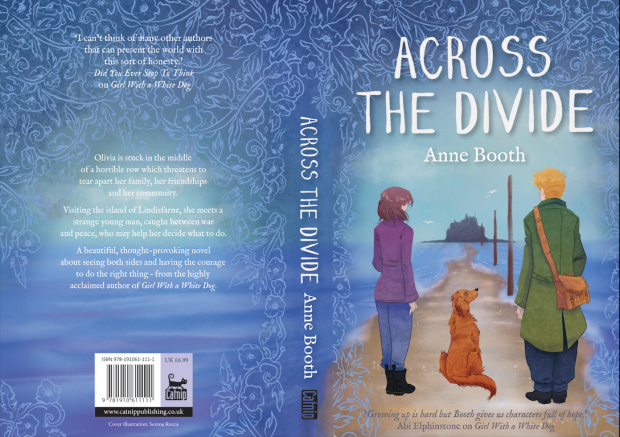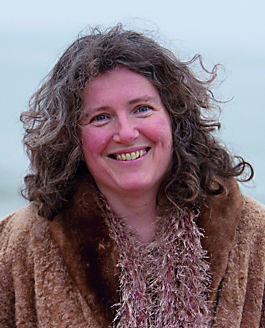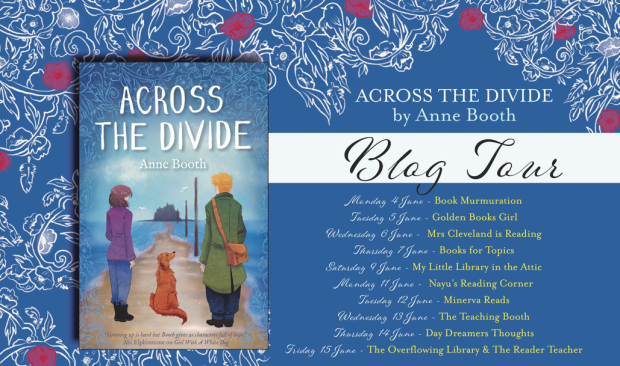
‘A book that broaches, binds, blends and bridges big issues…
This is more than historical fiction; this is a story movingly written in a one-of-a-kind way that ensures it will stay with you long after the last page is read.’
Rating: ⭐ ⭐ ⭐ ⭐ ⭐
Title: Across the Divide
Author: Anne Booth (@Bridgeanne)
Illustrator (Cover): Serena Rocca (@SerenaR_art)
Publisher: Catnip Books (@catnipbooks)
Page count: 320
Date of publication: 7th June 2018
Series status: N/A
ISBN: 978-1910611111
Perfect for Year 5, Year 6 & Year 7.
#3Words3Emojis:
1. Tolerance 😌
2. Lindisfarne 🏰
3. Divide ➗
Olivia is stuck in the middle of a horrible row that threatens to tear apart her family, her friendships and her community.
Visiting the island of Lindisfarne, she meets a strange young man, caught between war and peace, who may help her decide what to do.
A beautiful, thought-provoking novel about seeing both sides and having the courage to do the right thing – from the highly acclaimed author of Girl With a White Dog.
The first line:
The only thing I was absolutely sure about at the beginning of the holiday was that I didn’t want to go to Lindisfarne.
Review: After Olivia’s mother is imprisoned for leading a pacifist protest, she is sent to stay with her estranged father on one of author, Anne Booth’s, favourite places of the remote island setting of Lindisfarne. At first, she believes the island has nothing for her and wants to get as far away as possible from it because it’s about as far removed from the life that she’s used to as it could possibly be. However the island has a lot more to reveal of itself than Olivia could possibly first imagine…
Rowing, arguing and differences of opinion or ‘unhealthy’ debate make this a difficult time for Olivia, seeming to have put her home life in to disarray, so much so that we discover that she prefers living at her grandparents. Her grandfather, an ex-army man himself, is the polar opposite to his daughter, Caz – Olivia’s mum. Favouring the military, army life and the opening a new Army cadets programme at school, he encourages Olivia to take a similar path to him and helps her by signing the permission sheet, knowing full well that her mother will not, to enrol her in the cadet programme and even talking about it at her school. But what will her friends think of this and her…?
Divide. It is here where the title, ‘Across the Divide’ is rather apt for this book because small divides start to appear within Olivia’s friendship group, bigger ones within her family and the community; and when she meets William – a mysterious boy who lives in the castle – this in itself presents a larger divide between characters and eras that this book soon starts to span.
As the story progresses, Olivia learns for herself about the old adage of ‘actions speaking louder than words’ through a clever look back at the past as it meets with Olivia’s life in the present, and helps her to come to terms with making her own mind up and choosing the right thing to do for herself. But what does she choose to do…?
There’s elements of politics, contemporary issues and world events that Anne draws on in this story and they’re all handled in an age-appropriate style aimed at this audience with her hallmark of immense sensitivity, considerateness and compassion that echoes within the words of her previous books.
With links to the army, soldiers like Billy Congreve and conscientious objectors, this is particularly pertinent in the year when we commemorate the centenary of the ending of the First World War. I’d never visited Lindisfarne and had only vaguely heard about its historical background but now, thanks to reading Across in Divide, I feel like I have (albeit only for a short time) and that I’ve lived through a part of its history.
Highly topical, this is a book that broaches, binds, blends and bridges big issues including pacifism and peace and war and conflict. This book will do more than make you think because it will make you think differently about the world. This is more than just historical fiction; this is a story movingly written in a one-of-a-kind way that ensures it will stay with you long after the last page is read.
‘A book that broaches, binds, blends and bridges big issues…
This is more than historical fiction; this is a story movingly written in a one-of-a-kind way that ensures it will stay with you long after the last page is read.’
ACROSS THE DIVIDE by Anne Booth is out now in paperback (£6.99, Catnip Publishing)
Follow Anne Booth @Bridgeanne & Catnip @catnipbooks for more information.
Big thanks to Anne and Laura for sending me an advance copy of this wonderfully written book! Extra thanks to Anne for taking the time to answer my questions!
Mr E
📚

Author Q&A: Anne Booth (AB) with The Reader Teacher (TRT)

Anne Booth lives in a village in Kent with her husband, four teenage children, two dogs and two hens. She has worked as a bookseller, a guide round a haunted medieval building (though she didn’t see any ghosts), a table clearer and washer-upper, a teacher of English in Italy, an Arts and Crafts Coordinator in a residential Home for the Elderly and a University lecturer.
Anne’s talks about her most recently published book: Across the Divide; her reading and writing habits and using her book in the classroom. Her other books include Girl With a White Dog, Dog Ears, Refuge and Magical Kingdom of Birds series.
Across the Divide (5)
TRT: At The Reader Teacher, for my reviews, I describe books in #3Words3Emojis.
Which 3 emojis would you choose to best describe Across the Divide?
AB:
1. 🐕
2. ⌚
3. 🏰
TRT: What books, people, research, ideas and inspirations have helped you to write Across the Divide?
AB: I knew I wanted to write about Lindisfarne, because I love it so much. I am very interested in Lindisfarne Castle at the beginning of the twentieth century, at the time of Edward Hudson and Edwin Lutyens, and was moved to read in a National Trust booklet, the story of a boy, Billy Congreve, who stayed at the castle and then went off to fight in World War One. I feel that was a very poignant story.
I really like the words of the MP Jo Cox, who said that she found ‘we have far more in common with each other than things that divide us’ and in my own life, when I look at my friends, I think this is true, and wanted to write about that.
For ACROSS THE DIVIDE I have been inspired by knowing good people in the army and army cadets, including a very committed Christian who did active service in Afghanistan, but also by very close friends who have spent their lives as Christian Pacifists, one of whom has been frequently arrested for non-violent protests like the one Olivia’s mother does in the book. In my own family, one of my Irish grandfathers received the Distinguished Conduct Medal for his bravery whilst fighting as a soldier in the British Army in The First World War, and yet I know that he advised my father to never be a soldier. So I felt that there were very different, fascinating stories to tell and compelling but opposite viewpoints that could demonstrate connections made between people.
I was, as with Girl with a White Dog, aware of the stories being told our children by headlines in the newspapers, and I wanted to tell an alternative story about politics and where conflict is resolved and about unity and reconciliation, illustrating Jo Cox’s words.
I also wanted as part of this story, to show how religious people make decisions, and how people from the same religious tradition can make very different decisions about war, because I feel that there is a current tendency to fear religious belief and to identify religious commitment with extremism. I set in on an island associated with Christianity and used the debates between Christians at the time of the First World War, and in current debate. I hope that this will help children understand more about people from Christian and other religious traditions and how they follow their god or gods.
TRT: Across the Divide is set partly in Lindisfarne. For those of us (like myself!) who haven’t yet been to Lindisfarne, could you explain what it is like to visit or live on Lindisfarne?
AB: Lindisfarne is beautiful. It is a small island off the Northumberland coast which you can reach by driving or walking along a causeway, but it gets totally cut off when the tide comes in, and that gives it a unique atmosphere… It has the castle and the abbey, gift shops and heritage centres and lots and lots of birds. It has farms and fields with sheep, but also part of it is a nature reserve with wild dunes and bird-hides and secluded beaches and wild flowers. There is a particular sense of history and peace there, and some people say it is a ‘thin’ place, a place where the distance between heaven and earth is shorter. It has been an ancient place of pilgrimage for centuries, a cradle of Celtic Christianity, and was the birthplace of the stunningly beautiful Lindisfarne Gospels. I have been on holiday on Lindisfarne many times with my family, and I love it.
TRT: You talk about birds often in Across the Divide with mentions of sparrows and starlings, curlews and cormorants just to name a few. This is one of my favourite parts of the book. Can you explain their significance and tell us about your favourite bird and why it is?
AB: I love birds – I find them fascinating and mysterious and beautiful and I find it amazing that we share the world with them. I always feel there is something timeless about them and I love thinking that people we are divided from by time and history across the centuries, have also looked at the way a bird hovers in the air, or listened to bird song. There is an old gaelic poem about a monk listening to a blackbird singing, and I often think about that monk when I hear a blackbird and somehow feel connected over time. So this is all linked with the time travel section of the book, as well as a way of linking Olivia and her grandfather and Aidan and William together by their shared love of birds. It’s impossible for me to choose a favourite bird – I think they are all wonderful! I love the song of the blackbird and the call of the curlew, I love the cheekiness of sparrows and robins, and yesterday I was standing outside my house talking to a friend, and a fledgling blue tit flew down and landed on my shoulder for a minute, which is a highlight of my life!
TRT: If you were to choose the character that is most like you from Across the Divide, who would it be and why?
AB: I am not sure if any one character is like me. I’d love to be as brave as Riya or Aidan, but I don’t think I am. I can see lots of people’s points of view, so I am probably like Olivia, but I am not sporty and never wanted to join cadets. I’d love to be as enthusiastic as Stan the dog. I think, actually, it might be William, as I love dogs and birds and drawing and my own faith is very important to me, but again, I am not sure if I would be as brave – I hope so!
Reading and Writing (4)
TRT: What first attracted you to writing? Did you enjoy writing at school?
AB: I’ve always loved reading and I’ve always loved writing. I had very encouraging teachers and they used to let me illustrate my stories.
TRT: Which parts of writing do you find energise you and which parts do you find exhaust you?
AB: I love most things about writing. I can get a bit exhausted and muddled if I get too many story lines mixed up and the chronology of a story wrong and have to go back and sort out who did what, when. I have to remind myself to write down times and days beforehand. Luckily, editors are brilliant at helping me sort out any muddles!
TRT: When you were a child, can you remember contacting any authors or them ever visiting your school and if so, did this inspire you?
AB: I don’t remember any writers coming to visit our school or even thinking that I could contact them.
TRT: Currently, we seem to be living in a golden age of books, especially that of children’s literature. What are some of the interesting things or things you like that you’re seeing in other children’s books today? What are you reading, if you are reading any children’s (or adult’s) literature at the moment?
AB: I am really impressed by the wonderful range of children’s books at the moment, both in fiction and non-fiction. I love picture books and illustrated books and I also read lots of books for the age range I write for. I have just read To the Edge of The World by Julia Green, which is a wonderful story, and re-read The Secret of Spiggy Holes by Enid Blyton, I am currently reading and enjoying The Goose Road by Rowena House and loved Hilary MacKay’s new book The Skylarks’ War, which is out later this year – both are about the First World War, so link to ACROSS THE DIVIDE. A stunning picture book I read recently with gorgeous illustrations by Aurélie Blanz and a stunning text, is Just Like Brothers by Elizabeth Baguley. I am reading a wonderful adult non-fiction book called Curlew Moon by Mary Colwell and I’ve just read Dear Mrs Bird, a great adult novel set in the 2nd world war, brilliantly researched, by my friend AJ Pearce.
Across the Divide and Teaching (3)
TRT: Could you suggest ways that your book could be used in the classroom for the many teachers and school staff that will read this?
AB: I blogged about this at: https://www.booksfortopics.com/blog/author-blog-using-across-the-divide-in-schools
TRT: If you were to ‘pitch’ ACROSS THE DIVIDE in a sentence or two for teachers to use it in their classrooms or for parents to choose to read it at home, how would you sum it up?
AB: A book about standing up for what you believe, and about listening and respecting those with other viewpoints and finding common ground with them. A story which shows children that they have the power to make a difference.
TRT: For those teachers reading this Q&A and would like to enquire about arranging the opportunity of a school visit from yourself, how would it be best to contact you regarding this?
AB: I think contacting Catnip Books would be a good idea.

Be sure to check out the other dates and other bloggers for more reviews, posts and exclusive content from Anne on the Across the Divide blog tour from the past two weeks!












